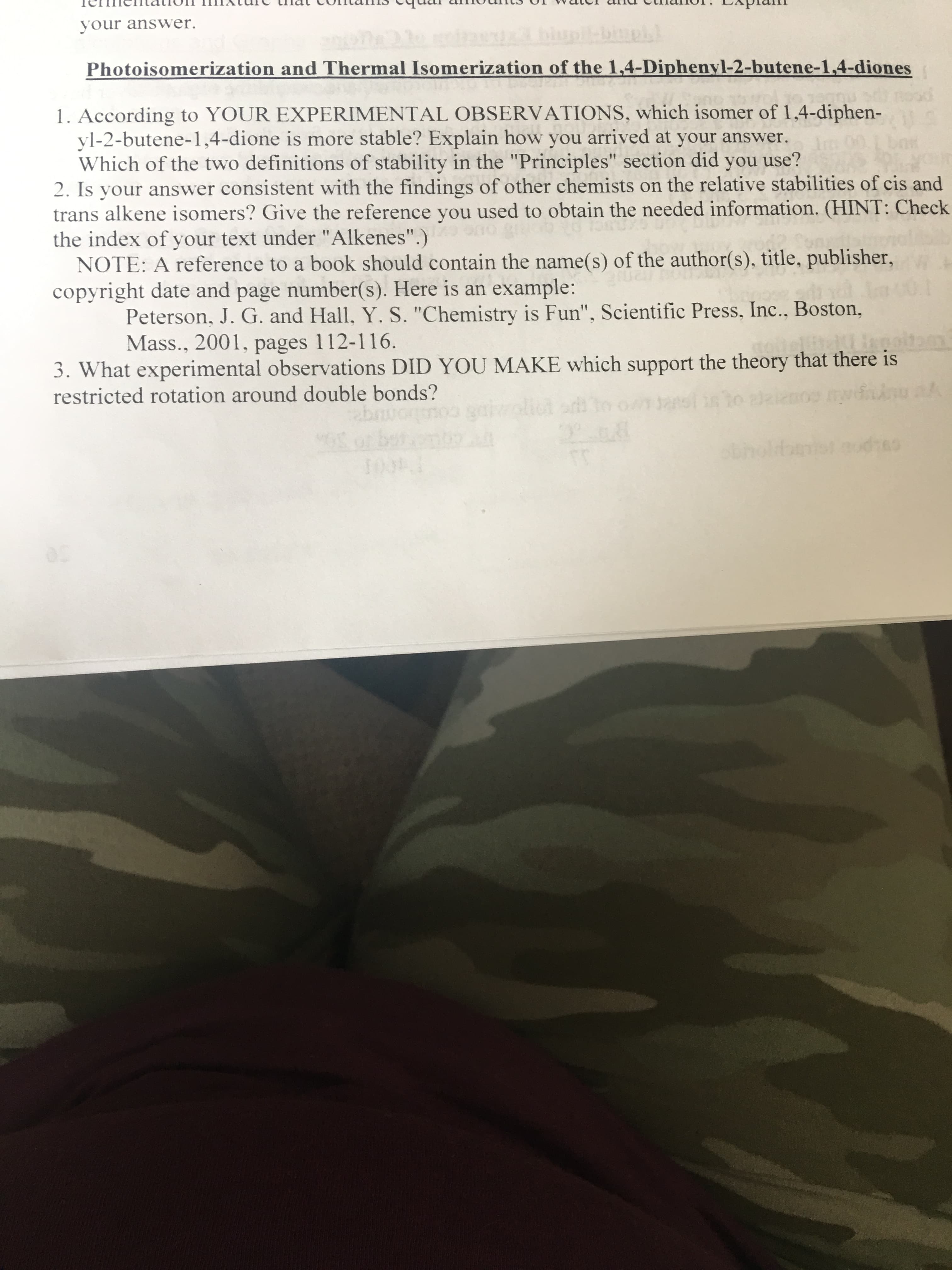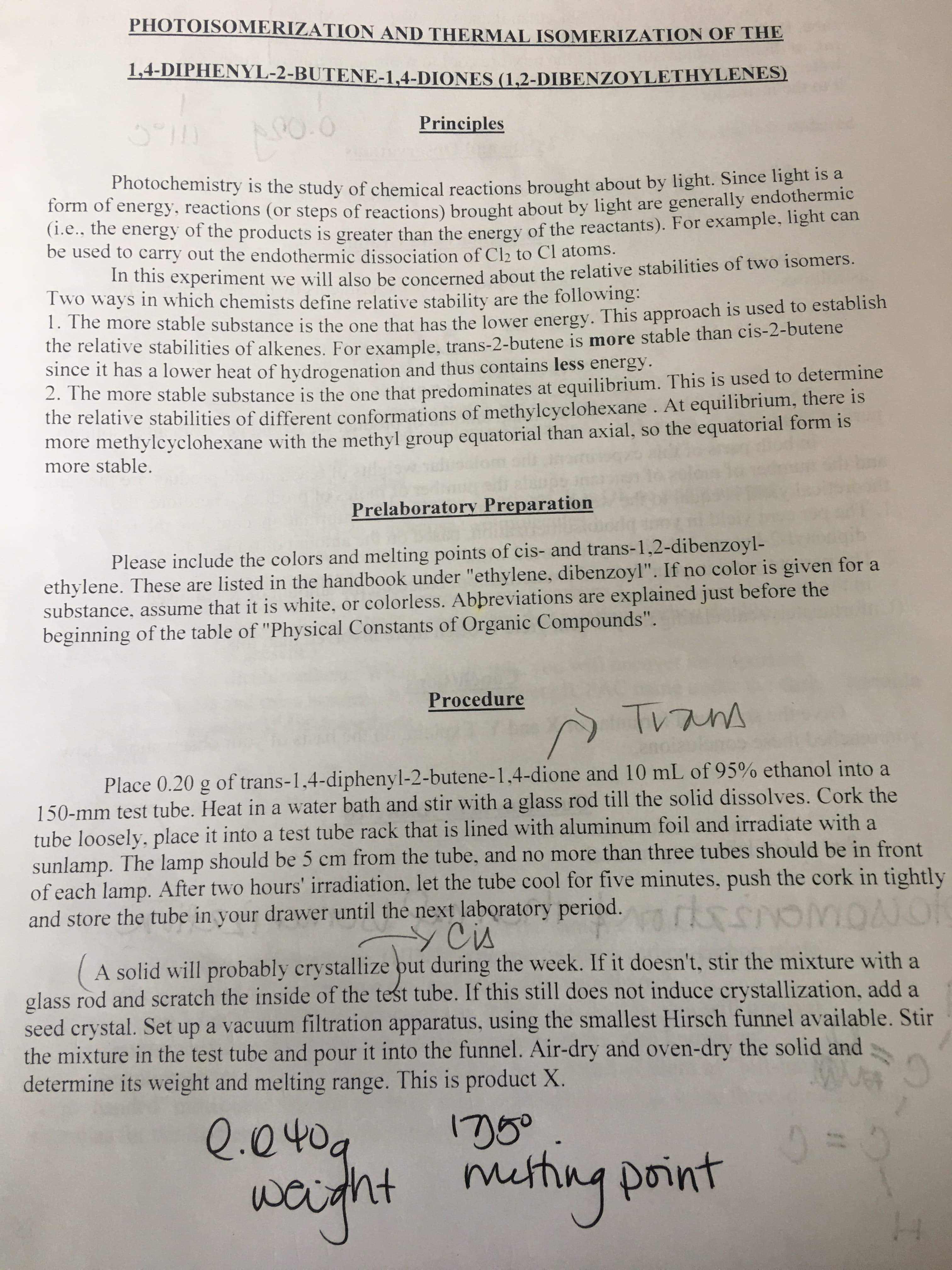your answer. ेर 21 Photoisomerization and Thermal Isomerization of the 1,4-Diphenyl-2-butene-1,4-diones 1. According to YOUR EXPERIMENTAL OBSERVATIONS, which isomer of 1,4-diphen- yl-2-butene-1,4-dione is more stable? Explain how you arrived at your answer. Which of the two definitions of stability in the "Principles" section did you use? 2. Is your answer consistent with the findings of other chemists on the relative stabilities of cis and trans alkene isomers? Give the reference you used to obtain the needed information. (HINT: Check the index of your text under "Alkenes".) NOTE: A reference to a book should contain the name(s) of the author(s), title, publisher, copyright date and page number(s). Here is an example: box Peterson, J. G. and Hall, Y. S. "Chemistry is Fun", Scientific Press, Inc., Boston, Mass., 2001, pages 112-116. 3. What experimental observations DID YOU MAKE which support the theory that there is nak 2 01U1TGE odas restricted rotation around double bonds? ga to 3245 Jo हदर्नील sbholbar 10 PHOTOISOMERIZATION AND THERMAL ISOMERIZATION OF 1.4-DIPHENYL-2-BUTENE-1,4-DIONES (1.2-DIBENZOYLETHYLENES Principles 00-0 Photochemistry is the study of chemical reactions brought about by light. Since light is a form of energy, reactions (or steps of reactions) brought about by light are generally endothermic (i.e., the energy of the products is greater than the energy of the reactants). For example, light can be used to carry out the endothermic dissociation of Cl2 to Cl atoms. In this experiment we will also be concerned about the relative stabilities of two isomers. Two ways in which chemists define relative stability are the following: 1. The more stable substance is the one that has the lower energy. This approach is used to establish the relative stabilities of alkenes. For example, trans-2-butene is more stable than cis-2-butene since it has a lower heat of hydrogenation and thus contains less energy. 2. The more stable substance is the one that predominates at equilibrium. This is used to determine the relative stabilities of different conformations of methylcyclohexane. At equilibrium, there is more methylcyclohexane with the methyl group equatorial than axial, so the equatorial form is more stable. Prelaboratory Preparation Please include the colors and melting points of cis- and trans-1,2-dibenzoyl- ethylene. These are listed in the handbook under "ethylene, dibenzoyl". If no color is given for a substance, assume that it is white, or colorless. Abbreviations are beginning of the table of "Physical Constants of Organic Compounds". explained just before the Procedure Tns Place 0.20 g of trans-1,4-diphenyl-2-butene-1,4-dione and 10 mL of 95% ethanol into a 150-mm test tube. Heat in a water bath and stir with a glass rod till the solid dissolves. Cork the tube loosely, place it into a test tube rack that is lined with aluminum foil and irradiate with a sunlamp. The lamp should be 5 cm from the tube, and no more than three tubes should be in front of each lamp. After two hours' irradiation, let the tube cool for five minutes, push the cork in tightly and store the tube in your drawer until the next laboratory period. STOMCTOR YCis A solid will probably crystallize out during the week. If it doesn't, stir the mixture with glass rod and scratch the inside of the test tube. If this still does not induce crystallization, add a seed crystal. Set up a vacuum filtration apparatus, using the smallest Hirsch funnel available. Stir the mixture in the test tube and pour it into the funnel. Air-dry and oven-dry the solid and determine its weight and melting range. This is product X WJek Q.040 - muthng print wouht
your answer. ेर 21 Photoisomerization and Thermal Isomerization of the 1,4-Diphenyl-2-butene-1,4-diones 1. According to YOUR EXPERIMENTAL OBSERVATIONS, which isomer of 1,4-diphen- yl-2-butene-1,4-dione is more stable? Explain how you arrived at your answer. Which of the two definitions of stability in the "Principles" section did you use? 2. Is your answer consistent with the findings of other chemists on the relative stabilities of cis and trans alkene isomers? Give the reference you used to obtain the needed information. (HINT: Check the index of your text under "Alkenes".) NOTE: A reference to a book should contain the name(s) of the author(s), title, publisher, copyright date and page number(s). Here is an example: box Peterson, J. G. and Hall, Y. S. "Chemistry is Fun", Scientific Press, Inc., Boston, Mass., 2001, pages 112-116. 3. What experimental observations DID YOU MAKE which support the theory that there is nak 2 01U1TGE odas restricted rotation around double bonds? ga to 3245 Jo हदर्नील sbholbar 10 PHOTOISOMERIZATION AND THERMAL ISOMERIZATION OF 1.4-DIPHENYL-2-BUTENE-1,4-DIONES (1.2-DIBENZOYLETHYLENES Principles 00-0 Photochemistry is the study of chemical reactions brought about by light. Since light is a form of energy, reactions (or steps of reactions) brought about by light are generally endothermic (i.e., the energy of the products is greater than the energy of the reactants). For example, light can be used to carry out the endothermic dissociation of Cl2 to Cl atoms. In this experiment we will also be concerned about the relative stabilities of two isomers. Two ways in which chemists define relative stability are the following: 1. The more stable substance is the one that has the lower energy. This approach is used to establish the relative stabilities of alkenes. For example, trans-2-butene is more stable than cis-2-butene since it has a lower heat of hydrogenation and thus contains less energy. 2. The more stable substance is the one that predominates at equilibrium. This is used to determine the relative stabilities of different conformations of methylcyclohexane. At equilibrium, there is more methylcyclohexane with the methyl group equatorial than axial, so the equatorial form is more stable. Prelaboratory Preparation Please include the colors and melting points of cis- and trans-1,2-dibenzoyl- ethylene. These are listed in the handbook under "ethylene, dibenzoyl". If no color is given for a substance, assume that it is white, or colorless. Abbreviations are beginning of the table of "Physical Constants of Organic Compounds". explained just before the Procedure Tns Place 0.20 g of trans-1,4-diphenyl-2-butene-1,4-dione and 10 mL of 95% ethanol into a 150-mm test tube. Heat in a water bath and stir with a glass rod till the solid dissolves. Cork the tube loosely, place it into a test tube rack that is lined with aluminum foil and irradiate with a sunlamp. The lamp should be 5 cm from the tube, and no more than three tubes should be in front of each lamp. After two hours' irradiation, let the tube cool for five minutes, push the cork in tightly and store the tube in your drawer until the next laboratory period. STOMCTOR YCis A solid will probably crystallize out during the week. If it doesn't, stir the mixture with glass rod and scratch the inside of the test tube. If this still does not induce crystallization, add a seed crystal. Set up a vacuum filtration apparatus, using the smallest Hirsch funnel available. Stir the mixture in the test tube and pour it into the funnel. Air-dry and oven-dry the solid and determine its weight and melting range. This is product X WJek Q.040 - muthng print wouht
Organic Chemistry
8th Edition
ISBN:9781305580350
Author:William H. Brown, Brent L. Iverson, Eric Anslyn, Christopher S. Foote
Publisher:William H. Brown, Brent L. Iverson, Eric Anslyn, Christopher S. Foote
Chapter9: Nucleophilic Substitution And Β-elimination
Section: Chapter Questions
Problem 9.27P
Related questions
Question

Transcribed Image Text:your answer.
ेर
21
Photoisomerization and Thermal Isomerization of the 1,4-Diphenyl-2-butene-1,4-diones
1. According to YOUR EXPERIMENTAL OBSERVATIONS, which isomer of 1,4-diphen-
yl-2-butene-1,4-dione is more stable? Explain how you arrived at your answer.
Which of the two definitions of stability in the "Principles" section did you use?
2. Is your answer consistent with the findings of other chemists on the relative stabilities of cis and
trans alkene isomers? Give the reference you used to obtain the needed information. (HINT: Check
the index of your text under "Alkenes".)
NOTE: A reference to a book should contain the name(s) of the author(s), title, publisher,
copyright date and page number(s). Here is an example:
box
Peterson, J. G. and Hall, Y. S. "Chemistry is Fun", Scientific Press, Inc., Boston,
Mass., 2001, pages 112-116.
3. What experimental observations DID YOU MAKE which support the theory that there is
nak
2 01U1TGE
odas
restricted rotation around double bonds?
ga
to
3245
Jo
हदर्नील
sbholbar
10

Transcribed Image Text:PHOTOISOMERIZATION AND THERMAL ISOMERIZATION OF
1.4-DIPHENYL-2-BUTENE-1,4-DIONES (1.2-DIBENZOYLETHYLENES
Principles
00-0
Photochemistry is the study of chemical reactions brought about by light. Since light is a
form of energy, reactions (or steps of reactions) brought about by light are generally endothermic
(i.e., the energy of the products is greater than the energy of the reactants). For example, light can
be used to carry out the endothermic dissociation of Cl2 to Cl atoms.
In this experiment we will also be concerned about the relative stabilities of two isomers.
Two ways in which chemists define relative stability are the following:
1. The more stable substance is the one that has the lower energy. This approach is used to establish
the relative stabilities of alkenes. For example, trans-2-butene is more stable than cis-2-butene
since it has a lower heat of hydrogenation and thus contains less energy.
2. The more stable substance is the one that predominates at equilibrium. This is used to determine
the relative stabilities of different conformations of methylcyclohexane. At equilibrium, there is
more methylcyclohexane with the methyl group equatorial than axial, so the equatorial form is
more stable.
Prelaboratory Preparation
Please include the colors and melting points of cis- and trans-1,2-dibenzoyl-
ethylene. These are listed in the handbook under "ethylene, dibenzoyl". If no color is given for a
substance, assume that it is white, or colorless. Abbreviations are
beginning of the table of "Physical Constants of Organic Compounds".
explained just before the
Procedure
Tns
Place 0.20 g of trans-1,4-diphenyl-2-butene-1,4-dione and 10 mL of 95% ethanol into a
150-mm test tube. Heat in a water bath and stir with a glass rod till the solid dissolves. Cork the
tube loosely, place it into a test tube rack that is lined with aluminum foil and irradiate with a
sunlamp. The lamp should be 5 cm from the tube, and no more than three tubes should be in front
of each lamp. After two hours' irradiation, let the tube cool for five minutes, push the cork in tightly
and store the tube in your drawer until the next laboratory period. STOMCTOR
YCis
A solid will probably crystallize out during the week. If it doesn't, stir the mixture with
glass rod and scratch the inside of the test tube. If this still does not induce crystallization, add a
seed crystal. Set up a vacuum filtration apparatus, using the smallest Hirsch funnel available. Stir
the mixture in the test tube and pour it into the funnel. Air-dry and oven-dry the solid and
determine its weight and melting range. This is product X
WJek
Q.040
-
muthng print
wouht
Expert Solution
This question has been solved!
Explore an expertly crafted, step-by-step solution for a thorough understanding of key concepts.
This is a popular solution!
Trending now
This is a popular solution!
Step by step
Solved in 2 steps

Recommended textbooks for you

Organic Chemistry
Chemistry
ISBN:
9781305580350
Author:
William H. Brown, Brent L. Iverson, Eric Anslyn, Christopher S. Foote
Publisher:
Cengage Learning

Organic Chemistry
Chemistry
ISBN:
9781305580350
Author:
William H. Brown, Brent L. Iverson, Eric Anslyn, Christopher S. Foote
Publisher:
Cengage Learning